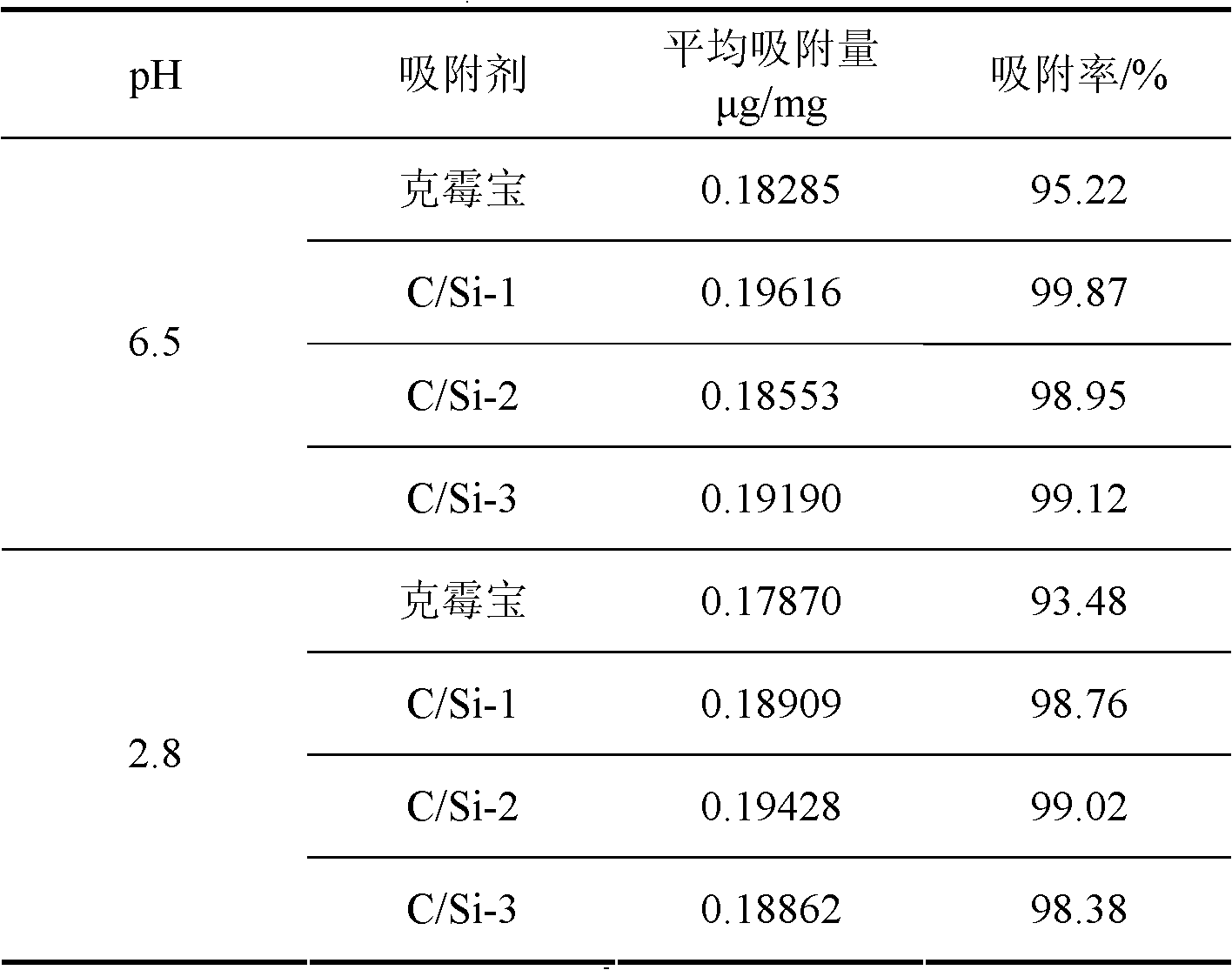Method for preparing mycotoxin adsorbent for efficient carbon silicon feed by taking rice hulls as raw materials
A technology of mycotoxins and adsorbents, which is applied in the field of preparing new high-efficiency carbon-silicon feed mycotoxin adsorbents, achieving the effects of abundant sources, obvious adsorption and retention effects, and broad prospects
- Summary
- Abstract
- Description
- Claims
- Application Information
AI Technical Summary
Problems solved by technology
Method used
Image
Examples
Embodiment 1
[0032] 1. Take 500g of rice husk and pass through a 60-mesh sieve, add 3L of deionized water, stir and wash with water for 20min after mixing, and separate by suction filtration. After repeating the steps of water washing and suction filtration for 3 times, use 3L of hydrochloric acid with a concentration of 0.05mol / L to pickle for 2h, then Then filter and wash with water until the washing liquid is neutral, then place the washed rice husks in an oven at 105°C to dry;
[0033] 2. Take 20g of washed and dried rice husks and put them into a crucible, and pre-carbonize them in a muffle furnace. The carbonization temperature is 250°C, and the carbonization time is 1h;
[0034] 3. Take 15g of the pre-carbonized sample, soak it in 100mL 5% KOH lye at room temperature for 12 hours, filter it with 80°C hot distilled water until the lotion is neutral, and dry it in an oven at 105°C for later use;
[0035] 4. Take 10 g of the sample that has been desiliconized with alkali, add 30% zinc ...
Embodiment 2
[0039] 1. Take 1000g of rice husk and pass through a 60-mesh sieve, add 5L of deionized water, stir and wash with water for 40min after mixing, and separate by suction filtration. After repeating the steps of water washing and suction filtration for 3 times, use 5L of hydrochloric acid with a concentration of 0.1mol / L to pickle for 2h, then Then filter and wash with water until the washing liquid is neutral, then place the washed rice husks in an oven at 105°C to dry;
[0040] 2. Take 20g of washed and dried rice husks and put them into a crucible, pre-carbonize in a muffle furnace, the carbonization temperature is 350°C, and the carbonization time is 2h;
[0041] 3. Take 15g of the pre-carbonized sample, soak it in 200mL 10% KOH lye at room temperature for 24 hours, filter it with 80°C hot distilled water until the lotion is neutral, and dry it in an oven at 105°C for later use;
[0042] 4. Take 10 g of the sample that has been desiliconized with alkali, add 50% zinc chloride...
Embodiment 3
[0046] 1. Take 750g of rice husk and pass through a 60-mesh sieve, add 4L of deionized water, stir and wash with water for 30min after mixing, and separate by suction filtration. After repeating the steps of water washing and suction filtration for 3 times, use 4L of hydrochloric acid with a concentration of 0.075mol / L to pickle for 2h, then Then filter and wash with water until the washing liquid is neutral, then place the washed rice husks in an oven at 105°C to dry;
[0047] 2. Put 20g of washed and dried rice husk into a crucible, and pre-carbonize in a muffle furnace. The carbonization temperature is 300°C, and the carbonization time is 1.5h;
[0048] 3. Take 15g of the pre-carbonized sample, soak it in 150mL 7.5% KOH lye at room temperature for 18 hours, filter it with 80°C hot distilled water until the lotion is neutral, and dry it in an oven at 105°C for later use;
[0049] 4. Take 10 g of the sample that has been desiliconized by alkali dissolution, add 40% zinc chlor...
PUM
| Property | Measurement | Unit |
|---|---|---|
| specific surface area | aaaaa | aaaaa |
| specific surface area | aaaaa | aaaaa |
| specific surface area | aaaaa | aaaaa |
Abstract
Description
Claims
Application Information
 Login to View More
Login to View More - R&D
- Intellectual Property
- Life Sciences
- Materials
- Tech Scout
- Unparalleled Data Quality
- Higher Quality Content
- 60% Fewer Hallucinations
Browse by: Latest US Patents, China's latest patents, Technical Efficacy Thesaurus, Application Domain, Technology Topic, Popular Technical Reports.
© 2025 PatSnap. All rights reserved.Legal|Privacy policy|Modern Slavery Act Transparency Statement|Sitemap|About US| Contact US: help@patsnap.com



